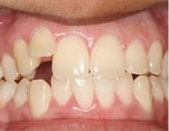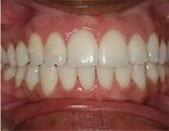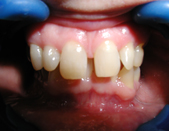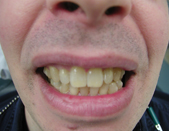WE OFFER
- Dentures
- Implants
- Root Canal
- Crowns (CAPS)
- Teeth Whitening
- Porcelain Laminates
- Bonding-White Fillings
- Treatment for Gum Disease
SEE SHORT VIDEO
See all videosInvisalign
Learn MoreHow Does Invisalign® Work?

Your Invisalign treatment will consist of a series of aligners that you switch out about every two weeks. Each aligner is individually manufactured with exact calculations to gradually shift your teeth into place.
And since your Invisalign system is custom-made for your teeth and your teeth only, with a plan devised by you and Dr. A. Fuzailof , you know you'll end up with a smile that truly fits.

If you're ready for a smile that transforms your appearance, Invisalign is your answer. Although there are many choices out there, no other works as effortlessly as the Invisalign system.
Custom made aligners are worn for about 2 weeks and are removed only to eat, drink, brush, and floss.
Each time an aligner is replaced with the next in the series, your teeth will move bit by bit.

In total about 18 to 30 aligners are worn in approximately 11 months. This of course will vary from case to case. Ask Dr. Fuzailof to demonstrate a sample case using our 3-D computer imaging technology.
Before and After Photo




The brighter smile
Orthodontics, the applied science of moving teeth, was developed with the intent of correcting the misalignment and malocclusion (improper bite) of teeth. While most people want that beautiful smile, Orthodontic correction also helps maximize the efficiency and function of teeth.
It does so by removing potential food traps created by crowded teeth, or teeth that are too far away. This allows for better access to clean more of the tooth surface helping reduce tooth decay and periodontal disease. Overcoming the effects of thumb-sucking, open bites or deep bites also fall under the prevue of orthodontic correction. Done properly these changes can recreate facial contour more effectively then any plastic surgery.
The field of Orthodontics has come a long way. Braces and wires are no longer the only way to correct overbites, overcrowding or open spaces between teeth.
The new method, Invisalign, has been in the market for the past decade. It has been used for over 750,000 patients. The system is based on work conducted by Dr. H.D Kesling in 1945. In the 1990’s the system, thanks to computer imaging, became cost effective.
Both traditional orthodontics and invisalign utilize the same type of constant pressure to manipulate and reposition teeth. While the results are fairly similar, the methods that generate these forces are very different.
Traditional orthodontics (called traditional because this was the only way to move teeth until recently) uses metal brackets and braces in combination with wires to create a point of pressure that either pulls or pushes a tooth, slowly forcing it to shift.
Invisalign uses removable clear plastic molds with build in pressure points to generate that same force. Each of these methods has clear advantages and disadvantages.
Advantages of Traditional Orthodontics:
Traditional braces are bonded onto the teeth and a wire is used to “guide” (persuade) the teeth to their intended new location. This is a tremendous advantage for the forgetful or non-compliant patient. With traditional orthodontics, once the braces are on the patient has no choice. The pressure is ever present.
The dentist simply makes a bi-weekly adjustment to the wire for the case to progress. Not showing up for those regular corrections simply ensures that the braces will stay in the person’s mouth longer.
There are several types of cases that can only be done with this method: Palatal Expansion, Molar Up-Righting etc.
Disadvantages include:
Esthetics- smiling now is a very self conscious effort.
Discomfort- wires can break; brackets de-bond and can require repositioning. The tongue and lips tend to become raw and sensitive in the initial stages of the treatment.
Average case: 2-3 years.
Braces, brackets and wires tend to trap food more readily then the smooth surface of the teeth. Oral hygiene has to be excellent and frequent to prevent these food traps from causing cavities or periodontal problems.
Invisalign advantages –
Invisalign uses a 3D image to develop calculated incremental and precise movements. In other words the patient can “see” what the case looks like before and after.
This system uses a series of clear removable trays, called aligners, to persuade the teeth to move to the desired location.
The removable aligner is ideal for oral hygiene. The aligners must be removed for meals and for brushing. The lack of Hardware (braces, brackets and wires) makes eating and brushing easier and more enjoyable.
Esthetics: a patient does not need to have Hardware (brackets, braces, and wires) showing every time they speak or smile. The aligners do take some getting used to, but most patients have a very hard time getting used to metal Hardware of traditional braces.
Treatment is shorter, particularly for compliant patients.
Invisalign disadvantages –
Gag reflex- people with high gag reflex may need the aligners trimmed to avoid triggering this particularly unkind reflex.
Compliance is the key to the success of Invisalign cases. Since the aligners can be removed, a forgetful or non-compliant patient may delay or disrupt treatment by not wearing their aligners. For such patients traditional braces may work better, because they are not removable.
Children have to be over 14 or have all their baby teeth out before they can qualify for this treatment.
Ancillary benefits:
The aligner also acts as a Night-Guard. For those who suffer from grinding or clenching their teeth at night get this additional benefit due to the design of the aligners.
Weight loss: Aligners must be removed before any meal or snack. After eating, the teeth should be brushed before wearing the aligners again. Compliant patients tend to avoid unnecessary snacks, limiting food intake to “must meals” only. A significant number of patients report some weight loss.
Whitening: The last set of aligners can be used as whitening trays. Anyone wishing to bleach their teeth, they only need to purchase the whitening paste ($200-$300 savings).
Many adults avoided any orthodontic work due it its cumbersome side effects. Seeing kids with braces is not unusual, but adults tend to be more self-conscious. Today, with new methods and benefits, many adults who shied away from orthodontic correction may want to revisit that option.

 718-380-2136
718-380-2136




